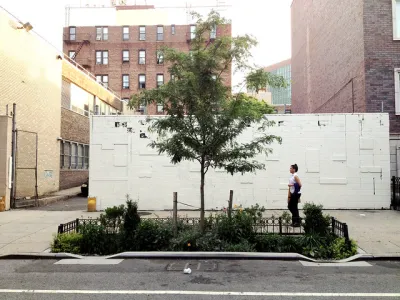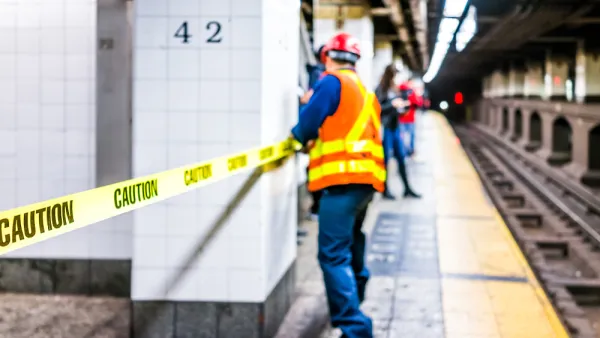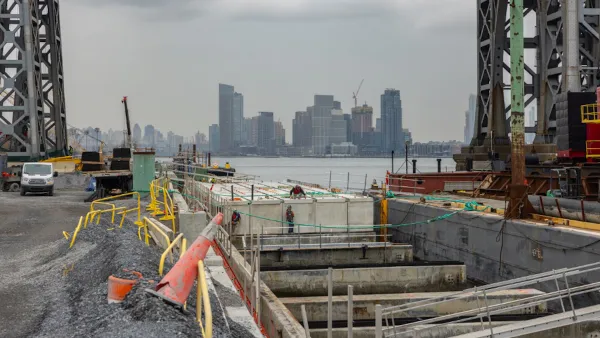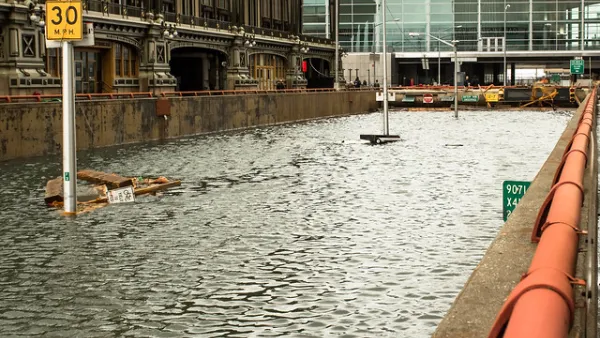To reduce the severity of disruptive subway flooding, the city can implement street-level solutions that absorb and redirect water before it reaches the train tunnels.

As climate change all but assures more catastrophic flooding in New York City, "experts say the city and the MTA can at least work on mitigating the worst of the floods by going green. Literally." To protect the city's subways and mitigate future floods, writes Dave Colon, "it’s incumbent on the city to create streets and sidewalks that can actually absorb water."
New York's subway system, according to the MTA, "can only handle rainfall of 1.75 inches per hour — an amount that used to be considered extremely rare, but isn’t anymore." In a 2018 lawsuit against Big Oil, the de Blasio administration acknowledged the increased risk by pointing out that "the number of days in New York City with rainfall at or above two inches is projected to increase by as much as 67% by the 2020s and the number of days with rainfall at or above four inches is projected to increase by as much as 67% by the 2020s and 133% by the 2080s."
Colon argues that "[s]treet design is a necessary, but neglected, weapon against flooding" that the city should implement more aggressively. And while experts praise the city's stormwater resiliency guide, Marcel Negret of the Regional Plan Association says the document takes "a siloed view of the transit system that the city relies on without owning," putting responsibility for flood prevention on the MTA without addressing street-level solutions like "street trees, bioswales and planters that manage excess stormwater."
FULL STORY: More Absorbent Streets Could Mean Less Flooded Subways

National Parks Layoffs Will Cause Communities to Lose Billions
Thousands of essential park workers were laid off this week, just before the busy spring break season.

Retro-silient?: America’s First “Eco-burb,” The Woodlands Turns 50
A master-planned community north of Houston offers lessons on green infrastructure and resilient design, but falls short of its founder’s lofty affordability and walkability goals.

Delivering for America Plan Will Downgrade Mail Service in at Least 49.5 Percent of Zip Codes
Republican and Democrat lawmakers criticize the plan for its disproportionate negative impact on rural communities.

Test News Post 1
This is a summary

Test News Headline 46
Test for the image on the front page.

Balancing Bombs and Butterflies: How the National Guard Protects a Rare Species
The National Guard at Fort Indiantown Gap uses GIS technology and land management strategies to balance military training with conservation efforts, ensuring the survival of the rare eastern regal fritillary butterfly.
Urban Design for Planners 1: Software Tools
This six-course series explores essential urban design concepts using open source software and equips planners with the tools they need to participate fully in the urban design process.
Planning for Universal Design
Learn the tools for implementing Universal Design in planning regulations.
EMC Planning Group, Inc.
Planetizen
Planetizen
Mpact (formerly Rail~Volution)
Great Falls Development Authority, Inc.
HUDs Office of Policy Development and Research
NYU Wagner Graduate School of Public Service





























